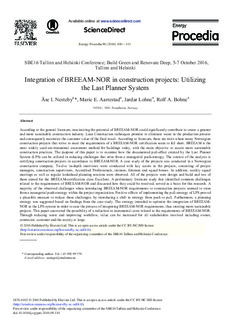| dc.description.abstract | According to the general literature, maximizing the potential of BREEAM-NOR could significantly contribute to create a greener and more sustainable construction industry. Lean Construction techniques promise to eliminate waste in the production process and consequently maximize the customer value of the final result. According to literature, these are traits where many Norwegian construction projects that strive to meet the requirements of a BREEAM-NOR certification seem to fall short. BREEAM is the most widely used environmental assessment method for buildings today, with the main objective to secure more sustainable construction practices. The purpose of this paper is to examine how the documented pull-effect created by the Last Planner System (LPS) can be utilized in reducing challenges that arise from a managerial push-strategy. The context of the analysis is certifying construction projects in accordance to BREEAM-NOR. A case study of the projects was conducted in a Norwegian construction company. Twelve in-depth interviews were conducted with key actors in the projects, consisting of project managers, construction supervisors, Accredited Professionals, trainees, foremen and squad bosses. In addition, weekly squad meetings as well as regular lookahead planning sessions were observed. All of the projects were design and build and two of them aimed for the BREEAM-certification class Excellent. A preliminary literature study that identified common challenges related to the requirements of BREEAM-NOR and discussed how they could be resolved, served as a basis for this research. A majority of the observed challenges when introducing BREEAM-NOR requirements to construction projects seemed to stem from a managerial push-strategy within the project organization. Positive effects of implementing the pull-strategy of LPS proved a plausible measure to reduce these challenges, by introducing a shift in strategy from push to pull. Furthermore, a planning strategy was suggested based on findings from the case study. The strategy intended to optimize the integration of BREEAM-NOR in the LPS-system in order to ease the process of integrating BREEAM-NOR requirements, thus creating more sustainable projects. This paper uncovered the possibility of a reduction in incremental costs related to the requirements of BREEAM-NOR. Through reducing waste and improving workflow, value can be increased for all stakeholders involved including owner, contractor, customer and the society at large. | nb_NO |

